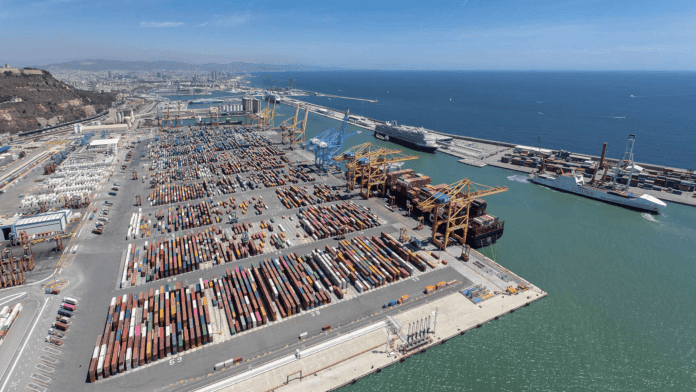Telefónica is to deploy a 5G network for Netherlands-based port operating company APM Terminals at the Port of Barcelona. The network, in a pilot phase, will be used to connect cranes, vehicles, and people in the port area, to manage traffic and improve worker safety. The project goes live next summer.
Telefónica will deploy 5G coverage in the port area in Barcelona. The new network will route at least some traffic off-site to the carrier’s data centre in Barcelona. The setup will incorporate 5G-based cellular vehicle-to-everything (C-V2X) to connect a number of the elements, including vehicles and machinery, and such things as streetlights.
Straddle carrier cranes will be equipped with 5G units, and connected on 5G for backhaul to the control room and data centre, located on site and in the city. They will connect to each other using C-V2X, as well as to other equipment and machinery in the port to establish a cooperative intelligent transport system (C-ITS) at the site.
Trucks, truck drivers, and terminal staff will use 5G-based smartphones, running the C-V2X application as well. A statement said: “The smartphone becomes another piece of the V2X environment, as well as the lever for an easy transition towards a fleet of natively connected vehicles and direct inclusion of people in the ecosystem.”
Data will be shared continuously, providing the live position and trajectory of machinery, vehicles, and people, enabling traffic coordination. An alarm system is to be implemented to warn of possible collisions and accidents. A dashboard will be provided to APM Terminals with a map of the positions of each of the “actors in the project”.
The companies involved said a positioning system will be layered in to provide location accuracy “as close as centimetres”. The C-ITS software will be housed in an edge node at Telefónica’s Virtual data centre (VDC) in the city. The edge infrastructure enables “very low” latency and “large” ‘real-time’ processing to extract “high value data”.
The main objective of the project is to minimise risk of collisions between mobile machinery and fixed elements in the container terminal. Depending on the results, the system could be replicated in other ports, the companies said. Telefónica said it is using the same mix of “traffic elements” in “other ports, airports, and all kinds of industrial sites”.
Mobile World Capital Barcelona, a public-private initiative with national and local government, which hosts Mobile World Congress with the GSMA, is also involved. It is promoting the project as part of its 5G Barcelona agenda to position Barcelona and Catalonia as the European city leader on 5G technologies.
Spanish car-parts maker Ficosa, which has engaged with Telefónica and SEAT previously to demo an Industry 4.0 concept with 5G and blockchain, is integrating the onboard unit C-V2X into the cranes, and helping with the C-ITS software and positioning service. HARMAN is involved in the C-V2X application on smartphones.
Carlos Arias, managing director of APM Terminals in Spain, said: “Projects like this are part of our… search [for] innovation and continuous improvement, and for operations in our terminal to be increasingly safe, more sustainable and more competitive.”

